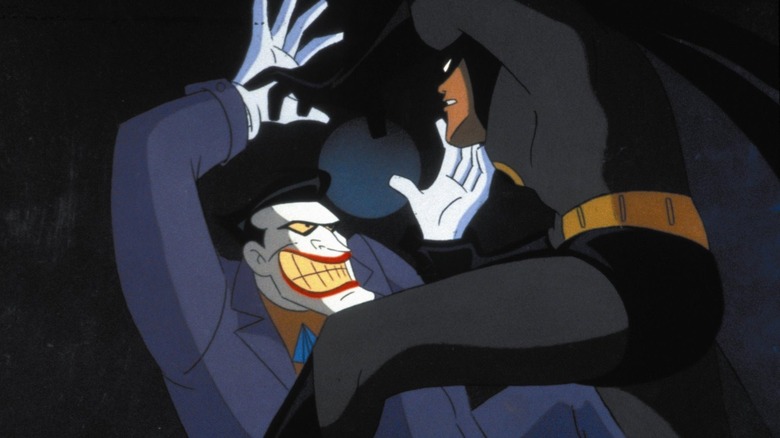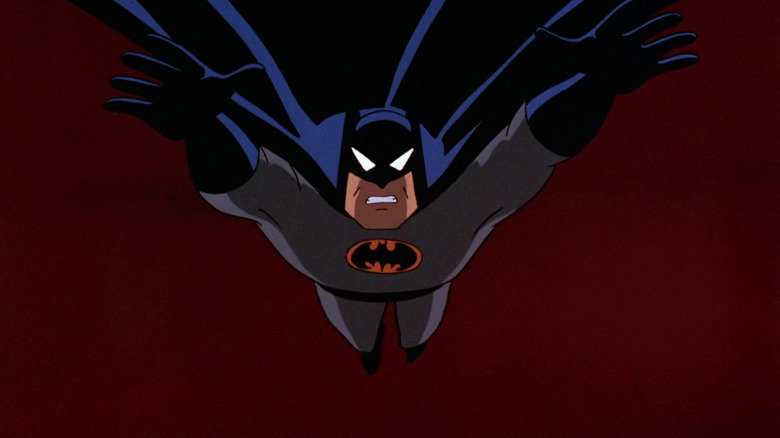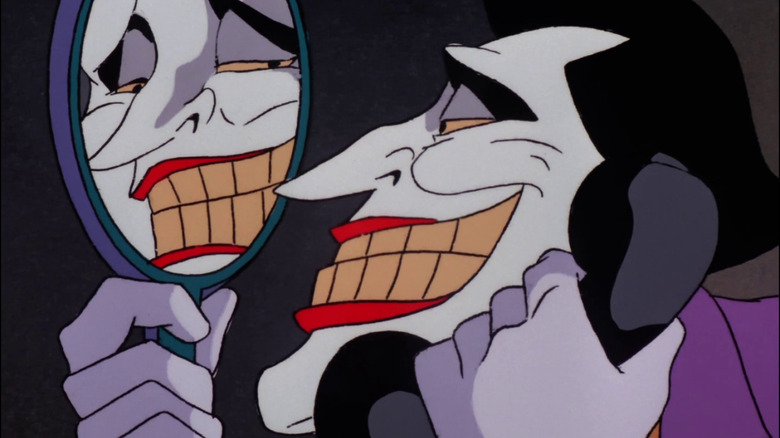Kevin Conroy And Mark Hamill Had A 'Rule' For Conversations Between Batman And The Joker
Tim Burton's 1989 film "Batman" was a hit the likes of which the world hadn't previously seen. In terms of cultural and advertising ubiquity, "Batman" even seemed to outstrip "Star Wars" in terms of its deep saturation. Burton's Gothic designs and Danny Elfman's Stravinsky-like score came to dictate a great deal of popular media that followed. Warren Beatty's 1990 film "Dick Tracy" is perhaps the most notable, big-budget "Batman" clone, using a lot of the aesthetic cues from "Batman," but adding more bright colors. Elfman also scored that film. Batman would then return in June of 1992 with "Batman Returns," an even stranger, more Gothic, more Stravinsky-inspired aesthetic.
The following September, Warner Bros. would keep Burton's stylized universe alive with Eric Radomski's and Bruce Timm's "Batman: The Animated Series," a show quite different from the bubblegum kid entertainment immediately surrounding it. "Batman: The Animated Series," like the Burton films, adjusted the world around Batman, creating an alternate version of Earth that could accompany such an outlandish figure. Grounding the character was voice actor Kevin Conroy who passed away on November 10 at the age of 66. Conroy played the part with stoic pathos, assuring viewers that there was nothing risible or campy about the series. The silliness would be provided by the show's numerous villain actors, most notably Mark Hamill in the part of the Joker.
In a 2014 interview with the DC Comics website, Conroy explained that the voice actors on "Batman" were recorded a little differently than most animated shows of the era, providing he and Hamill with an on-screen chemistry that they wouldn't be able to achieve otherwise. He and Hamill recorded in the same room together.
Andrea Romano
"Batman" was incredibly actor-friendly. The show's voices were directed by Andrea Romano, an animation veteran whose career began in the 1980s with her work on "Challenge of the Go-Bots." Romano was the casting director on hit shows like "The Smurfs" and "The Snorks" as well as notable Hanna-Barbera revivals like "The Jetsons," "The Flintstones Kids," and the era's "Scooby-Doo" shows. She became a voice director in 1987 on the Disney shows "DuckTales," and "Chip 'n' Dale: Rescue Rangers," eventually moving to Warner Bros. on "Tiny Toon Adventures" (on which she once acted in a cameo).
Romano, then, was experienced enough to know that having actors play off one another made for better performances. Traditionally, voice actors come in separately and record their lines independently of one another, leaving it to the editors to construct a scene. On "Batman: The Animated Series," everyone got to join in. Conroy, as one might intuit, preferred it that way, and felt that his scenes with Hamill were stronger for it. He said:
"Oh, we recorded together almost as a rule! That's a wonderful thing about Andrea Romano. She started out as an actor. So she has a real love for actors. She loves to work with them and has a great respect for them. She understands how actors work. She knows that to get the best performance from people, they need to be fed by other actors. If you're acting in a vacuum, it's just never as good. So she always insists on everyone being together."
Conroy even saw the sessions as looking like another medium, adding: "The bookings for all of 'Batman: The Animated Series' were done as radio plays where she'd have all the cast in a studio together, and as a result, those recordings were phenomenal."
Manic pixie nightmare boy
One might hear the chemistry in the scenes with Hamill and Conroy. Conroy was all business, growling with the best of them, rarely cracking a smile. Hamilly, meanwhile, was all smiles all the time, cackling and shrieking like, well, a comic book villain. It might have helped that Conroy came at Batman as an actor — he previously acted on stage and appeared on the soap opera "Search for Tomorrow" — and Hamill came at his role as both an actor and an animation historian. Hamill, Conroy pointed out, was certainly an expert. As he said:
"So Mark and I would work together as a rule, and we've always worked really well together. He's a very talented guy. And talk about someone with knowledge about the history of animation! He has an amazing animation collection and almost an encyclopedic knowledge of the history of the genre."
"Batman: The Animated Series" lasted for two seasons, ending in 1995. The show was then revived for a third season in 1997. Conroy's career settled into playing Batman almost exclusively, and he appeared as various versions of the character across TV shows, movies, and video games. He played the elderly version of Bruce Wayne in "Batman Beyond," and would playfully cameo Batman-like characters in other projects. For those of a certain age, Conroy defined the character and his passing is a great loss in the world of Batman and the world of voice acting.
Rest in peace.


